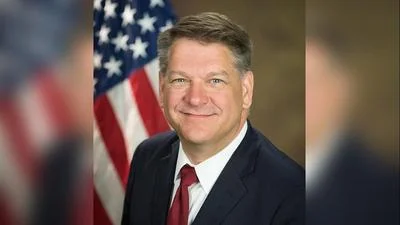Mike Nichols President | Official website
Mike Nichols President | Official website
Lest anyone doubt his intentions, the man charged as a would-be assassin of a U.S. presidential candidate left a letter, made public this week by the Department of Justice. “This was an assassination attempt,” the suspect wrote several months beforehand, “but I failed you. … It is up to you now to finish the job.”
He offered a $150,000 reward to do just that, and surely every American of goodwill hopes no one tries. We all reject politics by violence.
But if we all reject violence in politics, why does a mural on a government building on a prominent Milwaukee corner honor a woman who shot up the U.S. Capitol?
The mural’s been there for decades, but the matter is newly urgent: The latest almost-assassination follows by only two months the same candidate being grazed by a bullet fired at his head, and that candidate had to cancel a Wisconsin appearance due to the inability of the Secret Service to provide enough protection, a U.S. senator alleged this week.
You may guess the candidate’s name, but I’m deliberately skipping it because the name shouldn’t matter: No candidate should get shot, ever. We shouldn’t do politics by bullet. We all agree on that.
Yet Politico was reporting this week that a bipartisan swath of Congress now fears political violence enough to demand clearer succession plans. The paper quoted a source saying, “The number of rounds in one pistol clip can change the balance of power of the House or the Senate.”
Not an unreasonable fear, only six years after a man angry over election results tried blowing away one party’s congressional leadership as it practiced for a charity baseball game. It soon emerged that the perp had volunteered for a losing presidential campaign, the candidate of which, then in the U.S. Senate, said, “I am sickened by this despicable act. Let me be as clear as I can be; violence of any kind is unacceptable in our society.”
We all surely can agree with that candidate and senator Bernie Sanders of Vermont on that point.
Yet there’s that in Wisconsin’s largest city filling the side of the Milwaukee County Transit System’s bus barn at Mitchell Street and Kinnickinnic Avenue since the 1980s. It’s titled “Peacemakers.”
It features an intersectional array of proffered heroes: James Groppi, Aurora Weier, Vang Pao — so far so good — Rosa Parks, Chief Joseph, Nelson Mandela — all admirable.
But there’s Lolita Lebrón right in the middle posed before a Puerto Rican flag and labeled “freedom fighter.”
Seventy years ago last March she led three other Puerto Rican nationalists into U.S. House of Representatives visitor gallery where upon her signal all four started shooting indiscriminately at 243 members who were debating farm policy. The terrorists managed to hit five members before being overpowered.
What an odd way to be a “peacemaker.”
They’d all bought one-way tickets to D.C., expecting to die in nationalistic hail bullets but instead were sentenced to lengthy prison terms. Lebrón got 50 years but was given clemency after 25 by then-President Jimmy Carter which she later chalked up to political expediency having previously refused parole as it would have meant apologizing.
So why is Lebrón held up for Milwaukeeans as "peacemaker," hero?
I don’t know; she has no Wisconsin connection; her cause remains disputed among Puerto Ricans maybe it was progressive soft spot for revolutions.
It’s hard finding lingering news coverage from when mural went up maybe late 1980s when NAACP Youth Branch painted it no one bothered looking up what kind "freedom fighter" she was.
Wouldn’t first time activists became confused: After Madison statue Wisconsin abolitionist Civil War hero Hans Christian Heg torn down amid anti-Confederate iconoclasm 2020 some tried defending misfire claiming strategic political move.
I don’t know if good scratch Lebrón off wall rather like University Wisconsin-Madison building named after odious eugenicist Charles Van Hise maybe treat warning put sign pointing out tried slaughtering country first branch government shows how not make peace.
That would be useful warning because we are against political violence any kind right?
Right?
Some things make you start doubting.
Patrick McIlheran is Director Policy Badger Institute.
Any use reproduction Badger Institute articles photographs requires prior written permission request permission post articles website print copies distribution contact Badger Institute President Mike Nichols mike@badgerinstitute.org or 262-389-8239.






 Alerts Sign-up
Alerts Sign-up